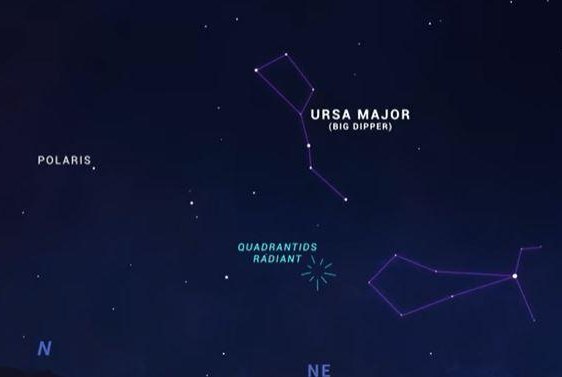The Quadrantid meteor shower rises appears to radiate from the constellation Bootes, as pictured. Image by NASA/JPL-Caltech
Jan. 3 (UPI) -- The Quandrantid meteor shower helped kick off the first workday of the new year on Monday, with the peak somewhat tough to see in North America -- but the rest of the world got a good show.
The "Quads" as they are nicknamed, are slated to peak around 4 p.m. EDT (2100 GMT) on Monday, according to Margaret Campbell-Brown and Peter Brown in the 2022 version of the Observer's Handbook of the Royal Astronomical Society of Canada, Space.com reported.
Skywatchers in North America will not be able to see its peak because it's the daytime, but it's ideal for skywatchers in East Asia, who could expect to see up to 60 to 120 meteors per hour.
While skywatchers in North America will miss the peak, they may have caught some Quadrantid activity in the predawn hours Monday morning, including 15 to possibly 30 meteors per hour.
The Quadrantids are cosmic debris shed by a near-Earth asteroid, known for producing bright blue meteors after the shower's peak and bright fireball meteors, which "are larger explosions of light and color that can persist longer than an average meteor streak," according to NASA.
A waxing crescent moon phase this year will allow for peak visibility of the Quadrantids, which peak each January, and are usually the strongest showers of the year, CNN reported.
The Quadrantids are named after an obsolete constellation "Quadrans Muralis," since the location of that constellation is the point in the sky from which it appears to come from.
French astronomer Jerome Lalande first observed the constellation in 1795, which was left off when the list when the International Astronomical Union created a list of recognized modern constellations in 1922.
The constellation's name came from an early astronomical instrument used to observe and plot star positions called a quadrant.
The meteor shower radiates between near the end of the handle of the Big Dipper, the site of Quadrans Muralis, and the modern constellation of Bootes, according to NASA.
The next meteor shower of the year, the Lyrid meteor shower, is slated to peak from April 21 into April 22 after a meteor shower drought of over three months, and produce around 15 shooting stars per hour.















